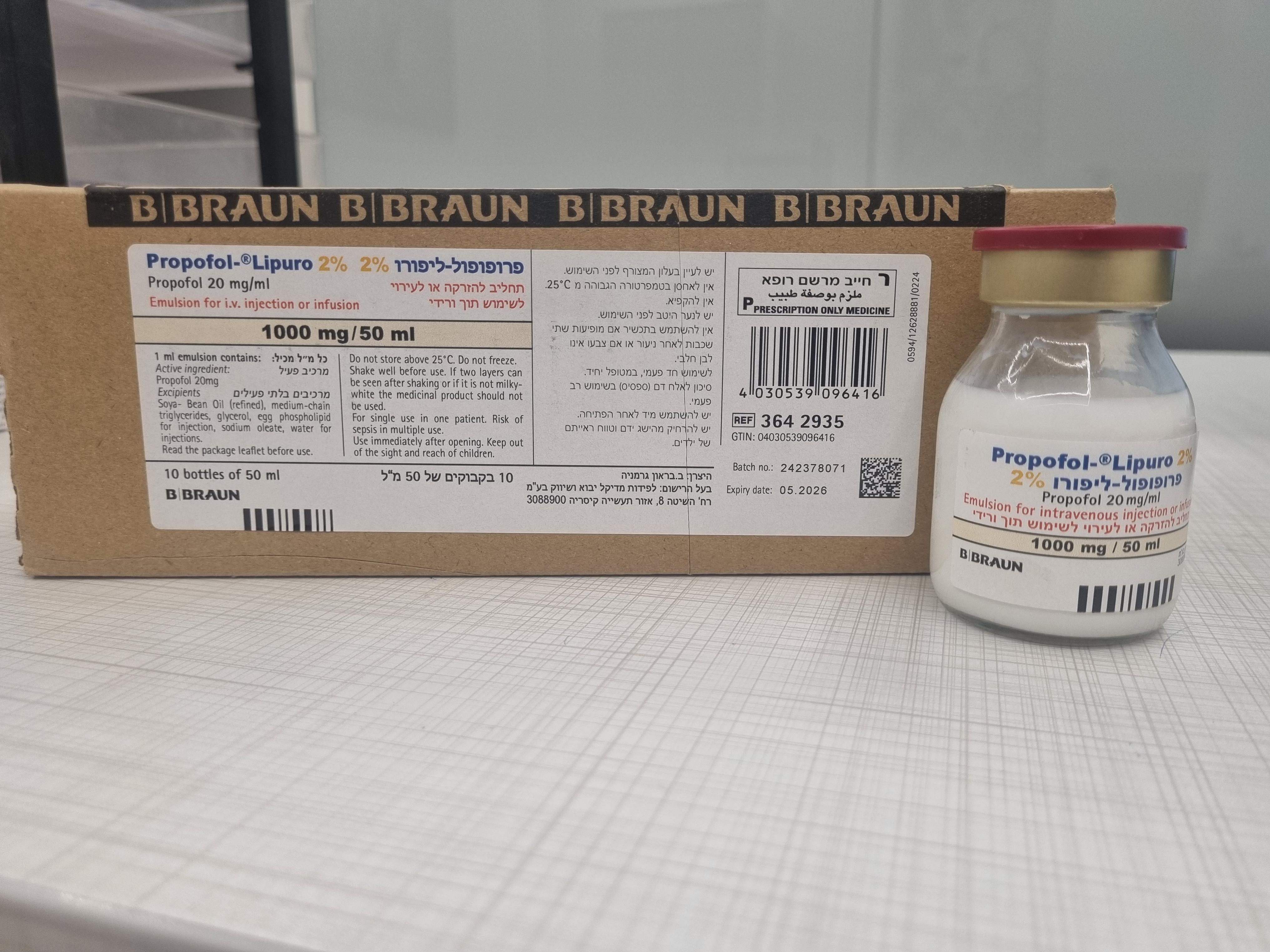Quest for the right Drug

פרופופול-ליפורו 2% PROPOFOL-LIPURO 2% (PROPOFOL)
תרופה במרשם
תרופה בסל
נרקוטיקה
ציטוטוקסיקה
צורת מתן:
תוך-ורידי : I.V
צורת מינון:
תחליב להזרקה או אינפוזיה : EMULSION FOR INJECTION OR INFUSION
עלון לרופא
מינוניםPosology התוויות
Indications תופעות לוואי
Adverse reactions התוויות נגד
Contraindications אינטראקציות
Interactions מינון יתר
Overdose הריון/הנקה
Pregnancy & Lactation אוכלוסיות מיוחדות
Special populations תכונות פרמקולוגיות
Pharmacological properties מידע רוקחי
Pharmaceutical particulars אזהרת שימוש
Special Warning עלון לרופא
Physicians Leaflet
Adverse reactions : תופעות לוואי
4.8 Undesirable effects General Induction and maintenance of anaesthesia or sedation is generally smooth with minimal evidence of excitation. Side effects during induction, maintenance and recovery occur uncommonly. The most commonly reported ADRs are pharmacologically predictable side effects of an anaesthet- ic/sedative agent, such as hypotension. The nature, severity and incidence of adverse events observed in patients receiving Propofol-Lipuro 2% may be related to the condition of the recipients and the op- erative or therapeutic procedures being undertaken. The following definitions of frequencies are used: Very common (≥1/10), common (≥1/100 to <1/10), uncommon (≥1/1,000 to <1/100), rare (≥1/10,000 to <1/1,000), very rare (<1/10,000) and not known (cannot be estimated from the available data). Table of Adverse Drug Reactions System Organ Class Frequency Undesirable Effects Immune system disorders Very rare Anaphylaxis – may include angi- oedema, bronchospasm, erythema and hypotension Metabolism and Nutritional Not known (9) Metabolic acidosis (5), hyper- disorder kalaemia (5), hyperlipidaemia (5) Psychiatric disorders Not known (9) Euphoric mood. Drug abuse and drug dependence (8) Nervous system disorders Common Headache during recovery phase Rare Epileptiform movements, includ- ing convulsions and opisthotonus during induction, maintenance and recovery Very rare Postoperative unconsciousness Not known (9) Involuntary movements Cardiac disorders Common Bradycardia (1) Very rare Pulmonary oedema Not known (9) Cardiac arrhythmia (5), cardiac failure (5), (7) Vascular disorders Common Hypotension (2) Uncommon Thrombosis and phlebitis Respiratory, thoracic and me- Common Transient apnoea during induction diastinal disorders Not known (9) Respiratory depression (dose- dependent) Gastrointestinal disorders Common Nausea and vomiting during re- covery phase Very rare Pancreatitis Hepatobiliary disorders Not known (9) Hepatomegaly (5), Hepatitis, acute hepatic failure (11) Musculoskeletal and connec- Not known (9) Rhabdomyolysis (3), (5) tive tissue disorders Renal and urinary disorders Very rare Discolouration of urine following prolonged administration Not known (9) Renal failure(5) Reproductive system and Very rare Sexual disinhibition breast disorders Not known Priapism General disorders and admin- Very common Local pain on induction (4) istration site conditions Very rare Tissue necrosis (10) following ac- cidental extravascular administra- tion Not known (9) Local pain, swelling, following accidental extravascular admin- istration Investigations Not known (9) Brugada type ECG (5), (6) Injury, poisoning and proce- Very rare Postoperative fever dural complications 1 Serious bradycardias are rare. There have been isolated reports of progression to asystole. 2 Occasionally, hypotension may require use of intravenous fluids and reduction of the administration rate of Propofol. 3 Very rare reports of rhabdomyolysis have been received where Propofol has been given at doses greater than 4 mg/kg/hr for ICU sedation. 4 May be minimised by using the larger veins of the forearm and antecubital fossa. With Propofol-Lipuro 2% local pain can also be minimised by the co-administration of lidocaine. 5 Combinations of these events, reported as “Propofol infusion syndrome”, may be seen in seriously ill pa- tients who often have multiple risk factors for the development of the events, see section 4.4. 6 Brugada-type ECG - elevated ST-segment and coved T-wave in ECG. 7 Rapidly progressive cardiac failure (in some cases with fatal outcome) in adults. The cardiac failure in such cases was usually unresponsive to inotropic supportive treatment. 8 Abuse of and drug dependence on propofol, predominantly by health care professionals. 9 Not known as it cannot be estimated from the available clinical trial data. 10 Necrosis has been reported where tissue viability has been impaired. 11 After both long- and short-term treatment and in patients without underlying risk factors. Dystonia/dyskinesia have been reported. Local The local pain which may occur during the induction phase can be minimised by the use of the larger veins of the forearm and antecubital fossa. Thrombosis and phlebitis are rare. Accidental clinical ex- travasation and animal studies showed minimal tissue reaction. Intra-arterial injection in animals did not induce local tissue effects. Reporting of suspected adverse reactions Reporting suspected adverse reactions after authorisation of the medicinal product is important. It allows continued monitoring of the benefit/risk balance of the medicinal product. Any suspected adverse events should be reported to the Ministry of Health according to the National Regulation by using an online form (https://sideeffects.health.gov.il).

שימוש לפי פנקס קופ''ח כללית 1994
לא צוין
תאריך הכללה מקורי בסל
לא צוין
הגבלות
לא צוין
מידע נוסף
